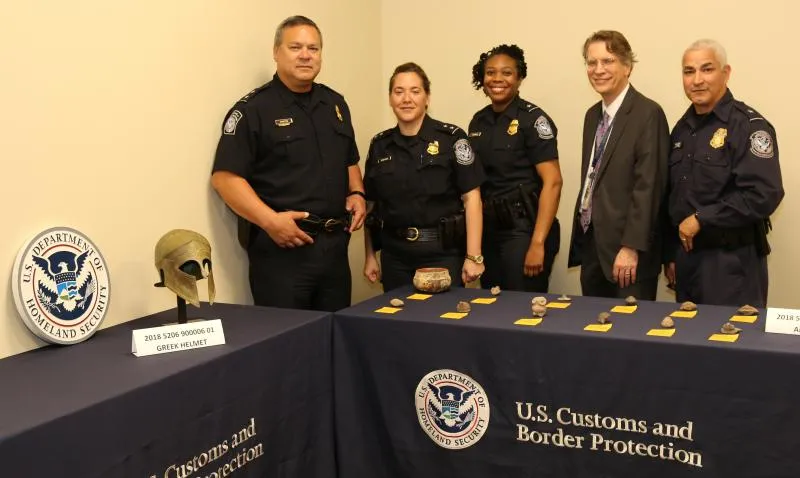MIAMI — U.S. Customs and Border Protection (CBP) officers and agriculture specialists at Miami International Airport recently intercepted two separate shipments containing ancient artifacts from Europe and Central America.

Port Director Christopher Maston,
Miami and Tampa Field Office
(MFO/TFO) Director of Field
Operations Diane Sabatino, MIA
Assistant Port Director for Trade
Operations Kemisha Sherrell,
MFO/TFO Assistant Director of
Field Operations for Trade Gregory
McCann and Director of Fines, Penalties,
and Forfeitures Robert Del Toro.
One of the shipments sent from the United Kingdom had been manifested as having a value of $252,000. Upon opening the wooden cargo container, what appeared to be a helmet was discovered. The item appeared to be an antique possibly dating back to ancient times.
The shipment documentation appeared incomplete and similar items have been deemed authentic and repatriated in the past. An expert appraiser was consulted and determined the item to be an authentic "Corinthian Helmet" dating back to 100-500 B.C.
CBP agriculture specialists at Miami International Airport selected the second shipment sent from El Salvador for an agriculture examination and discovered 13 individual pieces of pottery and figurines. The shipment manifest listed the contents as "Handicrafts".
The items appeared to be pre-Columbian and CBP detained the shipment for appraisal and authentication. An expert appraiser recently concluded the items are of Mayan origin. Some of the items date back to 300 A.D. while others date back to 1200 A.D.
"CBP's primary mission is to stop terrorists and their weapons from entering the homeland and the agency is also charged with facilitating lawful international trade and travel,” said Miami International Airport Port Director Christopher Maston. “The interception of these ancient antiquities is a great example of the role CBP plays in enforcing international repatriation laws of ancient artifacts."
Watch this video to learn more about CBP and its tremendously complex and important mission.
U.S. Customs and Border Protection operations in Florida include travel and trade facilitation and securing over 1,200 miles of the coastal border. Follow @CBPFlorida on Twitter for real-time updates.
Download U.S. Customs and Border Protection stock footage from DVIDS - Defense Video & Imagery Distribution System.

